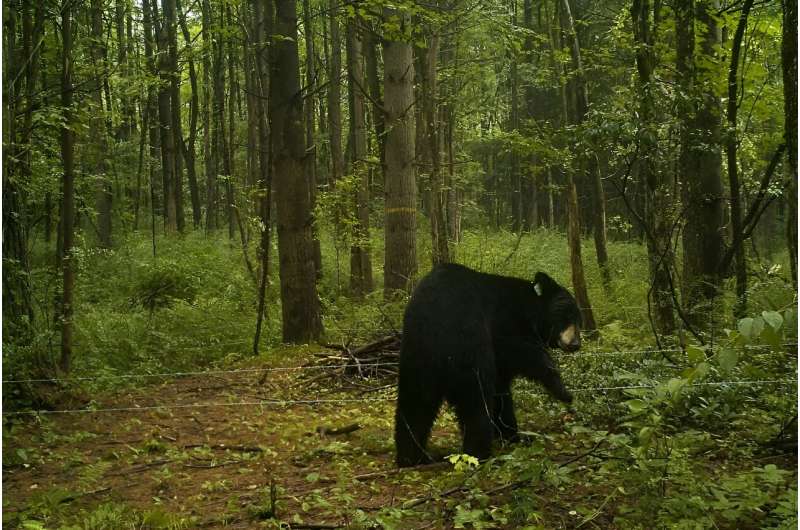This article has been reviewed according to Science X's editorial process and policies. Editors have highlighted the following attributes while ensuring the content's credibility:
fact-checked
trusted source
proofread
Lab sequences rabies in infected black bear

The Connecticut Veterinary Medical Diagnostic Laboratory (CVMDL) located within UConn's College of Agriculture, Health and Natural Resources (CAHNR) has sequenced a case of rabies from a black bear found in the state.
Cases of suspected animal illness in which there is no human exposure are sent to the CVMDL. Cases in which there is human exposure are the jurisdiction of the Connecticut Department of Public Health.
Whenever the CVMDL gets an animal that displayed signs of neurological disease, the first test they run is rabies. If they detect rabies, the CVMDL scientists do not proceed with a necroscopy as they could endanger the health of CVMDL staff.
"We rule out rabies because we don't want to do a necropsy that could expose people unnecessarily," says Guillermo Risatti, CVMDL director and professor in the Department of Pathobiology and Veterinary Science. "So, once we detect rabies, that's it. We don't do anything else with the carcass."
Risatti says while it is not uncommon to see animals with rabies in New England, in the lab's recent history this was only the second case of rabies in a bear they had ever encountered.
After detecting this rare positive case of rabies in a black bear, the CVMDL took the opportunity to sequence the entire genome of the virus and compare it with existing rabies sequences from other animals.
They compared the genome from the bear with a gene bank to which researchers globally submit sequences of rabies and other viruses.
They found that the virus, which was the only sample from a bear in the gene bank, most closely resembled a rabies virus sequence from a raccoon in New England.
These results were published in Microbiology Resource Announcements.
The researchers explain that sequencing and comparing these viral strains is important as it tells them about how viruses are circulating between animals and identify when a new virus comes onto the scene.
"That's the value—to see what the virus looks like and be able to distinguish a new virus coming into the area," Risatti says.
While there are very few cases of rabies in humans in the U.S., as humans continue to infringe upon wildlife habitat, including in Connecticut, people are more often in close proximity to wildlife making this kind of genetic monitoring increasingly important, Risatti says.
The researchers say that if they encounter another case of rabies in a bear, they intend to sequence that as well to add to the available data.
The CVMDL completed the same kind of genomic analysis of rabies in bats in 2022.
"All of the sequencing is done by us, here in house," Risatti says. "So that is the value. We have created a sequencing lab inside a diagnostic lab that is allowing us to dig more into what is going on."
According to the Connecticut Department of Energy and Environmental Protection (DEEP) there has been a dramatic increase in the number of black bear sightings in the state since the 1980s.
In the past few years, the CVMDL has seen an increase in the number of bears submitted to the lab for general testing. In 2023, nine bears were submitted to the CVMDL. By comparison, between 2019 and 2022 they only saw seven bears in total.
The CVMDL has not had a bear submitted to them yet in 2024. But they note this is not unusual as bears usually hibernate until mid-March.
The bear involved in this case was found in Canton, Connecticut in February 2023. Residents reported noticing a black bear acting strangely. The bear, which should have still been hibernating, was falling over and did not respond to human presence. Once dead, the bear was sent to the CVMDL for testing.
According to DEEP, if you see a bear, you should:
- Observe it from a distance.
- Advertise your presence by shouting and waving your arms or walk slowly away.
- Never attempt to feed or attract bears.
- Report bear sightings to the Wildlife Division (or email wildlife@ct.gov).
If an animal appears to be distressed, which may include symptoms like stumbling, staggering, walking in circles, dragging a limb or the hind end, or otherwise acting strangely, DEEP advises people to never attempt to handle the animal as it may be rabid. Instead, they should call their local animal control officer or police department.
More information: Zeinab H. Helal et al, The complete coding sequence of a rabies lyssavirus (RABV) detected in an American black bear ( Ursus americanus ) in Connecticut, USA., Microbiology Resource Announcements (2024). DOI: 10.1128/MRA.00821-23
Provided by University of Connecticut



















